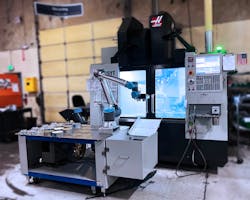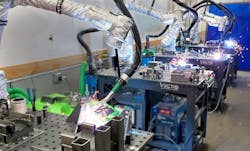Open-source control architectures and end-effector innovations steer the future of user-friendly cobots
Chris Savoia is regional head of UR+, Americas, at Universal Robots. He answered some pertinent questions about robotic integration.
As industrial robot installations continue to rise, they continue to be integrated into work cells for palletizing, machine tending, welding and other industrial applications. What innovative or efficient robot-integration applications have you seen or been involved with?
What have been the biggest improvements to robot integration and interoperability with other robots or components in work cells in the past five years?
Chris Savoia, regional head of UR+, Americas, Universal Robots: The robot operating system (ROS) has been a great boon for the industry. Admittedly, ROS is oftentimes more complex and requires more experienced programming skills than is ideal, since it requires the use of a Linux terminal. But ROS has allowed very sophisticated robot systems to be deployed without needing a Ph.D. in robotics, especially since ROS2 has launched, which fixes a lot of the architectural problems of ROS1. Universal Robots maintains an active ROS2 driver that can be used by startups, researchers and other developers to build reliable, innovative products from our platform.
Can you explain how software or open-source control architectures have changed robotic integration?
As manufacturers and warehouses/distribution centers push toward autonomous operations, what is the benefit of collaborative robots (cobots) and their ability to work alongside humans?
Chris Savoia, regional head of UR+, Americas, Universal Robots: Universal Robots is good at human-scale automation, especially for tasks that take about the same physical space and run at about the same rate as a human operator. Along the same lines, the cobots tend to fit better alongside human operators, without as much extensive re-engineering of the workspace. Oftentimes, cobot work cells can even be set up to have the cobot be removable and easily wheeled away so a human can step in to retool machines and set up new jobs. Safety is an important factor here; new innovations in reliably sensing humans present in the work cell means cobots can get closer to human and still have a high safety performance level and thus a solid risk assessment.
When will robotics technology become user-friendly enough that integration, installation, and operation is plug-and-play and no longer requires extensive engineering?
Chris Savoia, regional head of UR+, Americas, Universal Robots: This depends on the task the cobot is doing. We currently see in the welding industry that it is possible for operators—the actual welders doing the current task manually—to take a cobot and teach it how to do things, without the need for an automation or a manufacturing engineer to weigh in. This means that collaborative robots are already user-friendly enough, so that the teaching of the task can be put directly into the hands of the domain expert doing the actual work on the floor.
What future innovations will impact the integration of robotics technology in work cells and with other industrial machinery?
Chris Savoia, regional head of UR+, Americas, Universal Robots: Looking further out, generative artificial intelligence (AI) and the use of large language models (LLMs) should push collaborative robotics to be even easier to use then they are now. Cobots will be more natural with tasking in their environments. Currently, it is often necessary for humans to put themselves in the cobots’ shoes and think about how a cobot should be programmed for a certain task. With generative AI, humans will be able to talk to cobots normally and have the them understand the subtle context and intent behind simple commands.
Tell us about your company’s state-of-the-art robotic integration into a work cell or transporting materials/goods between cells.
Chris Savoia, regional head of UR+, Americas, Universal Robots: Universal Robots manufactures collaborative robots that are innovative in safety, ease-of-use and with a unique ecosystem of peripherals, which allows the adoption of automation in an extensive array of applications in almost any industry. Our mission is to allow humans to work with robots, not like robots.
About the Author
Mike Bacidore
Editor in Chief
Mike Bacidore is chief editor of Control Design and has been an integral part of the Endeavor Business Media editorial team since 2007. Previously, he was editorial director at Hughes Communications and a portfolio manager of the human resources and labor law areas at Wolters Kluwer. Bacidore holds a BA from the University of Illinois and an MBA from Lake Forest Graduate School of Management. He is an award-winning columnist, earning multiple regional and national awards from the American Society of Business Publication Editors. He may be reached at [email protected]

Leaders relevant to this article:



